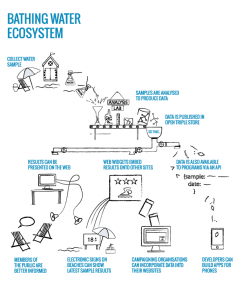Epimorphics has just completed a project with the Environment Agency to publish the seasonal bathing water quality data as linked data. This linked data can be explored and re-used by members of the public, software developers and data scientists alike.

How clean are bathing waters, coastal and inland, that we like to swim in during the summer? Each year, under the guidance of the European Bathing Water Directive, the countries of Europe collect scientific data to monitor the cleanliness of bathing waters. In England and Wales, that duty falls to the Environment Agency (EA). Each week during the bathing water season, which runs from May to September, EA personnel sample the bathing water sites around the country and analyse those water samples to check the water quality. Specifically, EA scientists look for at the numbers of bacterial colonies whose presence suggest that there is unpleasant material – sewage – in the water.
While the results of water quality tests can be obtained from the EA’s Wiyby site, it wasn’t previously possible for people outside EA to get access to the data. The goal of our project was to change that, by making the data underlying the water quality reports available as linked data. Linked data uses ideas and technologies from the World Wide Web to make data as easily available, to both human readers and to programs, as normal web content. It’s data you can click on. In a linked data approach every item of data has a web address, known as a URI. In addition, the properties and classes used to describe the data also have URI’s, so the data becomes meaningful to computer programs in a way that, for example a spreadsheet, is not.
One of the main reasons for publishing linked data is to make the data available to developers and data scientists to create new apps and visualizations. We provided Environment Agency with:
- a data model to describe bathing waters and water samples as meaningful linked data;
- an automated publishing platform so that incremental updates – the weekly sample results – can be published as linked data as soon as they’re available from the lab;
- a set of API’s and developer documentation, allowing web developers to access the data easily in JSON and other web-friendly formats. These bathing water API’s are built using the design patterns in the Linked Data API as implemented by Elda;
- a reference application – the Bathing Water Data Explorer which provides a user-friendly web interface to allow people to explore the available data. One of the features of the reference web application is that it brings together in one place both the water quality sample data and the more general bathing water profile data that EA hold, illustrating that one of the main benefits from a linked data approach is data integration.
Please contact Martin Merry if you are interested in finding out more details about this project.
